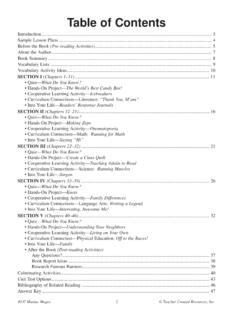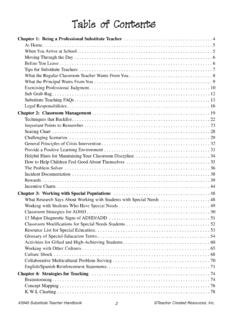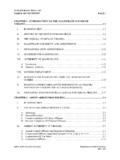Transcription of Introduction Table of Contents - cdn.teachercreated.com
1 TCR 8183 STEM Teacher Created Resources2 IntroductionTable of ContentsIntroductionChallenges vs. Lessons ..3 Standards and Assessments ..4 Meeting the Challenges ..5 Budgets ..8 Challenge Overview ..11 STEM Vocabulary for Every Challenge ..13 Engineering Design Process ..14 Scientific Inquiry ..15 ChallengesAnimal Life Cycles (Reproduction) ..16 Animal Adaptations (Organism Survival) ..24 Oil-Spill Cleanup (Environmental Change) ..35 Make It Move! (Effects of Unbalanced Forces) ..45 Crash Testing (Testing Variables) ..54 Traps (Change in Motion) ..64 Shelters (Force and Motion) ..75 Towers Stack Attack (Center of Gravity) ..86 Magnet Maze Game (Magnetic Forces) ..95 Bottle Flipping (Controlling Variables) ..102 Next Generation Science Standards Correlation ..11175 Teacher Created Resources TCR 8183 STEMF orce and MotionSheltersObjectiveStudents will design and build models of shelters that can stand and keep occupants safe in high FocusEarth and Space Science: A variety of natural hazards result from natural processes.
2 Humans cannot eliminate natural hazards, but they can take steps to reduce their Science: Each force acts on one particular object and has both strength and direction. Forces that do not sum to zero can cause changes in the object s speed or direction of Design: Define a simple design problem reflecting a need or a want that includes specified criteria for success and constraints on materials, time, or cost. Make a claim about the merit of a design solution that reduces the impacts of a weather-related and Engineering Practices: Ask questions and define problems; construct Concepts: Cause and effect: stability and changeSetupFor Main Challenge You will need at least two building materials in each of the following categories:Supports for structure: straws, skewers, craft sticks, uncooked spaghettiConnectors: pushpins, string, toothpicks, rubber bands, pipe cleaners Note: No tape or glue!
3 Something to make walls: fabric, paper, foil, cut-up trash bags (12" 18" pieces) Set up the testing area by plugging in the fan and placing the fan on a Table . Use tape to mark out an area about 3 feet in front of the fan where students will take turns placing their complete shelters for Introduction and Mini Challenge The Three Little Pigs (pages 81 82) Shelter Examples (page 83) small paper cup, one per pair straws, 1 per studentMain Challenge Shelters (page 84) Reflections Shelters (page 85) 20" 30" (approx.) corrugated cardboard or foam core boards, one per group electric fan (multi-speed if possible) markers materials for building (See Setup.) scissors small paper cups, two per groupTime FrameThe Introduction and Mini Challenge can be completed in one class session of about 20 minutes.
4 The Main Challenge can be completed in about 45 60 minutes. Follow up with the Writing Reflection as time balanced force gravity resist shelter unbalanced windPart of the challenge is that no tape or glue is allowed. Most students will use the pushpins to anchor the structure to the foam core. If you want to make it more of a challenge, take away the Teacher Created Resources TCR 8183 STEMS heltersMini Challenge (cont.)Part 2 1. Have students pair up, and give each pair a small paper cup and two straws. 2. Explain that the cup will be their pig for this activity. The cup should be placed upside down. Allow a minute or so for them to draw a face on the pig if they like. 3. Have students place their pig between them on a desk or Table . Ask: Are there forces working on the pig?
5 (Most will probably say no because the pig is not moving.) 4. Have one student blow through the straw towards the pig so that the pig moves. Ask: What force was making the pig move? (The push of the air when you blow.) 5. Give the second student a chance to blow on the pig. Ask students to describe what they see. What is happening with the forces on the pig? (The pig moves when we blow on it, or The force of the air makes the pig move.)Force and Motion79 Teacher Created Resources TCR 8183 STEMF orce and MotionSheltersMain ChallengeDefine the Problem 1. Tell students that they will be building a shelter for two pigs (small paper cups) that will protect them from the huffing and puffing of the wolf (electric fan). 2. Share the constraints for the challenge with students. Write them on the board, post them, or make copies of them for each group.
6 3. Show students the fan setup for testing their shelters. Hold a sheet of paper in front of the fan as you demonstrate all of the speed settings. Safety Note: Make it clear that you (or another adult) are the only one allowed to touch the fan. 4. As a class, decide on the criteria for success, , At the lowest fan speed, the house stands, and the pigs are safe inside for 10 seconds, or The pigs stay upright inside the shelter for 30 seconds. 5. Let students know that, if their shelter passes the test on the lowest fan setting, they can elect to try faster fan speeds. 6. Let students look at and handle the building materials. Let students know that no tape or glue will be used in this challenge! 7. Review the Engineering Design Process (page 14) with students. Let them know that they can test and revise their designs as many times as they like in the time available.
7 If you plan to challenge students by pricing materials and giving them a budget, add the budget to the constraints. (See pages 8 10.)TeacherNoteChallenge Constraints The pigs must fit completely inside the shelter. The pigs must be able to enter and exit the shelter (needs a door). The pigs must not be restrained in any way. Use only the materials provided. You do not have to use all of the materials. During testing, two students may use two fingers to hold the base of their shelter to the Table . Super Challenge Constraint (optional): The shelter must not be attached to its 8183 STEM Teacher Created ResourcesRecording SheetForce and Motion Name _____ Date _____Shelters 1. What basic shape will you use for your structure? 2. List the materials that you will use to build your structure.
8 3. Draw a diagram of your structure. 4. On your diagram, draw an arrow to show the direction of the force from the fan. 5. How will your shelter resist the force of the wind?














